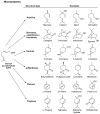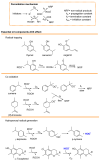Essential Oils: Chemistry and Pharmacological Activities
- PMID: 37509180
- PMCID: PMC10377445
- DOI: 10.3390/biom13071144
Essential Oils: Chemistry and Pharmacological Activities
Abstract
In this review, we provide an overview of the current understanding of the main mechanisms of pharmacological action of essential oils and their components in various biological systems. A brief introduction on essential oil chemistry is presented to better understand the relationship of chemical aspects with the bioactivity of these products. Next, the antioxidant, anti-inflammatory, antitumor, and antimicrobial activities are discussed. The mechanisms of action against various types of viruses are also addressed. The data show that the multiplicity of pharmacological properties of essential oils occurs due to the chemical diversity in their composition and their ability to interfere with biological processes at cellular and multicellular levels via interaction with various biological targets. Therefore, these natural products can be a promising source for the development of new drugs.
Keywords: anti-inflammatory; antibacterial; anticancer; antifungal; antioxidant; antiviral; medicinal plants; metabolites; natural products; volatiles.
Conflict of interest statement
The authors declare no conflict of interest.
Figures







References
-
- Guenther E. The Essential Oils: Individual Essential Oils of the Plant Families Gramineae, Lauraceae, Burseraceae, Myrtaceae, Umbelliferae and Geraniaceae. 4th ed. Van Nostrand; Paris, France: 1950. pp. 1–752.
-
- Association Française de Normalisation (AFNOR) Huiles Essentielles, Tome 2, Monographies Relatives Aux Huiles Essentielles. 6th ed. AFNOR, Association Française de Normalisation; Paris, France: 2000.
-
- Do T.K.T., Hadji-Minaglou F., Antoniotti S., Fernandez X. Authenticity of essential oils. TrAC Trends Anal. Chem. 2015;66:146–157. doi: 10.1016/j.trac.2014.10.007. - DOI
-
- Sell C. Chemistry of essential oils. In: Bașer K.H., Buchbauer G., editors. Handbook of Essential Oils. Science, Technology, and Applications. CRC Press; Boca Raton, FL, USA: 2010. pp. 121–150.
Publication types
MeSH terms
Substances
LinkOut - more resources
Full Text Sources

